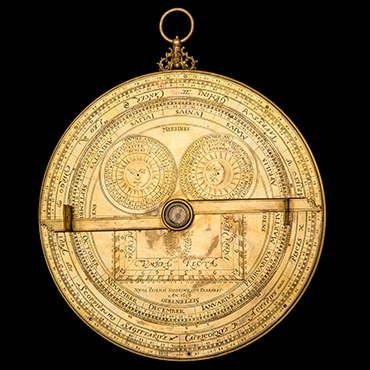The Museu de Marinha was established in Lisbon in AH 1279/1863 CE by the sailor-king Luís I
(r. AH 1277–1307/1861–89 CE) as a collection of artifacts related to Portuguese maritime activity. Over a century and a half since its founding, the Portuguese Maritime Museum has become an institution of utmost importance in national culture.
The core of the museum’s collections are the models previously held by the royal family and the Academia Real de Guardas-Marinhas (Royal Academy of Midshipmen), predecessor of the Portuguese Naval Academy. Upon his death in AH 1367/1948 CE, collector Henrique Maufroy de Seixas bequeathed a magnificent collection of objects related to the sea—a gift that transformed and elevated the collection into a maritime museum. In AH 1381/1962 CE, the Museu de Marinha moved to its current location next to the Jerónimos Monastery. The museum’s collection comprises more than 24,000 objects. Key works are the richly decorated royal galliots and the seaplane that allowed Portuguese Navy officers to complete the first air crossing of the South Atlantic, as well as warships, traditional boats, and pleasure crafts.
The Museu de Marinha recognizes that most of the tools used in 9th-century AH/15th-century CE navigation are based on Islamic instruments, including the mariner’s astrolabe, nautical charts, and the lateen sail of caravels. The Museu de Marinha joins AlMadar with a presentation of astrolabes and sailing charts of the Indian Ocean.
Mariner’s astrolabe “São Julião da Barra III”
The Mariner’s astrolabe was an adaptation by the Portuguese in the late 9th to 10th centuries AH/15th to 16th centuries CE that allowed sailors to know their latitude position without having land in sight. It was a crucial tool for sailing from the North Atlantic to the Indian Ocean. This exceptional astrolabe is called São Julião III after the site where the carrack Nossa Senhora dos Mártires (Our Lady Mary of the Martyrs) was lost, at the entrance of the river Tagus. The ship and most of its passengers had survived the almost two-year voyage, only to founder with Lisbon in sight. The astrolabe is engraved with the date AH 1013/1605 CE, which documents when the ship left Lisbon on her way to India.
It has survived in almost pristine condition because it was resting under an iron cannon that protected it from corrosion. Strong currents, winds, and shallow waters make the waters of the fortress of São Julião da Barra one of the most difficult sites to interpret given the dynamics of soil movements.
The three-year campaign to study the remains of the carrack Nossa Senhora dos Martires
(AH 1414-17/1994-97 CE) is the only scientific excavation of a Portuguese ship of the Portuguese-India run.
Made by Francisco de Goes Raposo
Recovered from shipwreck Nossa Senhora dos Mártires
Portugal, AH 1013/1605 CE
Bronze, diam. 17.4 cm
Ministério da Cultura – Património Cultural, IP, MM.04619

